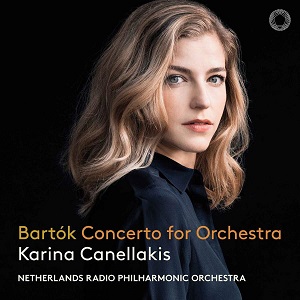
Bela Bartók (1881-1945)
Four Orchestral Pieces, Op 12 Sz 51 (1912 orch. 1921)
Concerto for Orchestra, BB123 Sz 116 (1943)
Netherlands Radio Philharmonic Orchestra/Karina Cannellakis
rec. live, July 2022, Muziekcentrum van de Omroep, Hilversum, Netherlands
Pentatone PTC5187027 [63]
Although the cover understandably features the Concerto for Orchestra, Bartók’s most popular work, this disc begins with a comparative rarity, the Four Orchestral Pieces which were Bartók’s next orchestral composition after the opera Bluebeard’s Castle. At the time, younger composers were preferring to write sets of orchestral pieces called just that, rather than symphonies or suites. Schoenberg, Berg and Webern all contributed sets of orchestral pieces, and Stravinsky’s Four Studies for Orchestra are not far distant.
However, Bartók’s set has never been popular. Halsey Stevens, in his standard work on the composer, is very severe about them, saying: ‘Had he persisted in the direction represented by the Four Pieces, it must have led to a morass of stagnation.’ Conductors have tended to be equally unenthusiastic: some of those strongly associated with the composer, such as Doráti, Kubelik, Solti and Ivan Fischer, never recorded them. Boulez, however, was an exception. So, this was an enterprising choice for Karina Canellakis to choose for the first of what promises to be a continuing series of recordings with the Netherlands Radio Philharmonic Orchestra, of which she was recently appointed Chief Conductor.
The work could not have a better advocate. The opening Preludio is magical, an impressionist tapestry recalling the flower garden in Bluebeard’s Castle. There follows a Scherzo, which is fast and furious, like the chase in The Miraculous Mandarin, which was to follow a few years later, but perhaps without the bite of that work. The Intermezzo is a precursor of the night music idiom, which Bartók was to develop later, with plaintive woodwind wisps of melody over a soft cushion of multiply divided strings. The final Funeral March is perhaps rather episodic, though each episode is powerful. Throughout this performance I noted with pleasure the precision and snap of the rhythms, the exact and beautiful chording of the wind and brass, the excellence of the wind soloists and the ardour of the strings. Radio orchestras are often thought of as being in the second rank, but not this one here.
After this outstanding performance, I have to report that the Concerto for Orchestra is merely very good. The opening Introduzione struck me as slightly dogged until the Allegro Vivace burst in. The second movement, the Game of Couples, with pairs of wind instruments each having their turn in the limelight, was wholly delightful and witty too. The third movement, the Elegy, opens with flurries on the wind over string chords reminiscent of the lake of tears in Bluebeard’s Castle, now thirty years earlier. It builds to a searing climax, a really tragic movement. Then follows the Interrupted Intermezzo, complete with the famous parody of a passage from Shostakovich’s seventh symphony, the Leningrad, which had recently appeared in the most difficult circumstances and was being widely praised. This goes well, but I felt the parody passage lacked that element of fun which I believe to be part of Bartók’s conception. The finale is one of Bartók’s dance movements, which goes at a tremendous speed and provides ample opportunity to show off the orchestra’s virtuosity.
As I said, this is a very good performance, even if, for me, it is not revelatory as is that of the Four Pieces. The playing is of the same quality as in the earlier work. The recording is excellent, and I was particularly pleased to be able to hear the harp when it appears, though the credit for this should probably go to Canellakis rather than to the engineers. Canellakis also wrote the interesting sleevenote, in English only.
This is the only recording I am aware of with this coupling. Boulez recorded the Four Orchestral Pieces twice, in 1972 for Sony and again in 1993 for DG. The 1972 recording has been my go-to version, and it still sounds pretty good, but Canellakis obviously benefits from a more recent recording and offers a possibly superior performance. I have not heard the 2013 version by Edward Gardner, but my colleague Dan Morgan thought he made only ‘a decent job’ of it (review) and preferred Botstein (review). As for the Concerto for Orchestra, there are many recordings, and I note only the classic one by Fritz Reiner and a personal favourite, Kubelik’s Boston version for DG, now on a Presto CD. However, those who opt for this new version will not be disappointed. I look forward to future recordings by Canellakis with her orchestra.
Stephen Barber
Help us financially by purchasing from





















